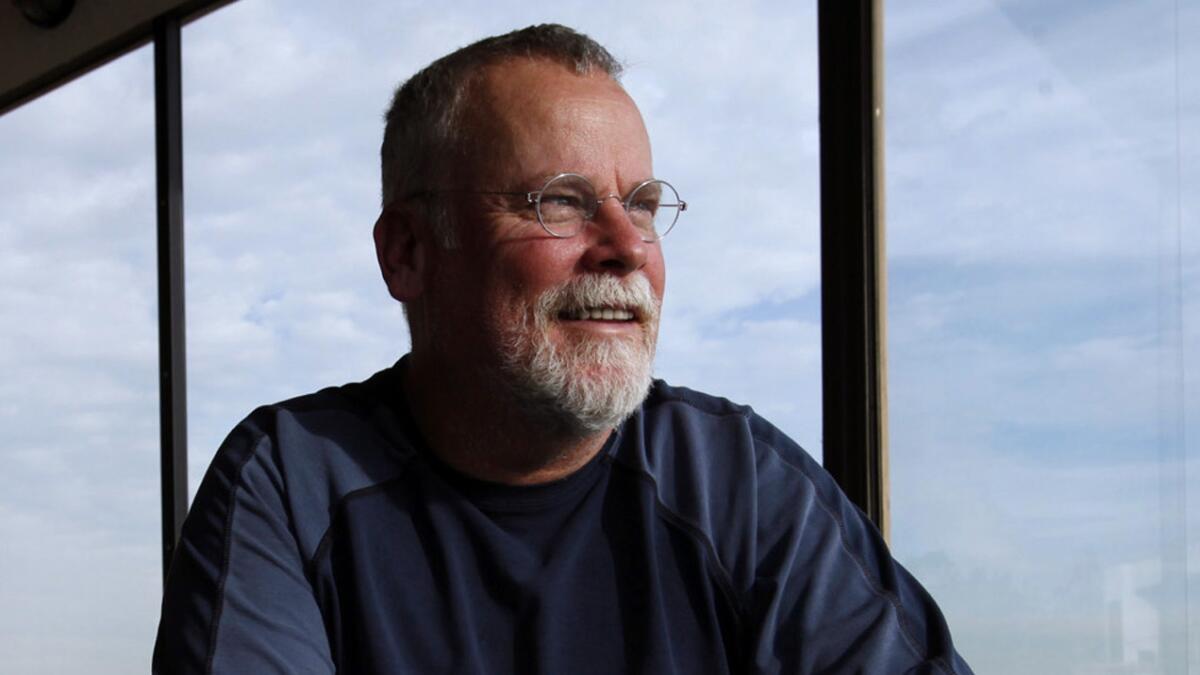Michael Connelly’s Harry Bosch is still fighting the good fight in ‘The Wrong Side of Goodbye’

- Share via
One of the decisions series fiction writers must make is whether to let their characters age or keep them anchored to a specific time period. There is no right or wrong choice, as the success of Sue Grafton can attest — her heroine, Kinsey Milhone, has aged less than 10 years over 24 novels. Conversely, Michael Connelly’s seminal hero, Hieronymus “Harry” Bosch, first appeared in his early forties, when he served on the LAPD Hollywood Division’s Homicide unit (1992’s “The Black Echo”), followed by stints in the department’s storied Robbery-Homicide Division, early retirement and forays into private investigation work, before returning to the LAPD, where he worked in RHD’s Open-Unsolved Unit until being forced into retirement in his mid-sixties.
“The Wrong Side of Goodbye” finds Bosch, like many baby boomers, working a couple of jobs to keep himself busy and contributing to the private-college education of his daughter. Bosch’s PI work pays the bills while he undertakes volunteer work investigating cold cases at the San Fernando Police Department, a small municipal force recently decimated by cutbacks, keeping him close to his mission of getting justice for crime victims.
For the record:
11:37 a.m. June 10, 2025This article misspells the name of Sue Grafton’s literary heroine as Kinsey Milhone. The fictional character’s surname is Millhone.
Bosch’s latest private client comes to him through John Creighton, a former LAPD deputy chief and now a well-heeled executive at Trident Security, providing “high-level security for those who can afford it.” One of Trident’s clients, Whitney Vance, is the wealthy and powerful chairman of Advance Engineering, a company that supplies helicopters and stealth technologies to the U.S. military. Vance has personally requested Bosch for an assignment he will only reveal to the detective. The request for a meeting with Vance — accompanied by a $10,000 check for his trouble — sends Bosch to the reclusive billionaire’s Pasadena mansion, where he learns that Vance wants Bosch to locate a possible child and heir, born around 1950 when the then-USC engineering student fell in love and fathered a child with a 16-year-old Mexican immigrant named Vibiana Duarte. Vance’s father forbade the relationship and presumably sent Duarte away, perhaps back to Mexico. Now 85 and near the end of his life, Vance wants Bosch to secretly find Duarte and their now middle-aged child so he can make amends.
Bosch sneaks in database searches during his hours as volunteer reservist with the San Fernando PD. He must tread carefully in his search for Duarte and her child — not only would Advance Engineering’s Board of Directors and Trident’s security minions do anything to thwart his efforts of find an heir to the Vance fortune and company, but accessing law enforcement databases on non-police business is both a firing offense and a violation of California law.
The cold case he’s working on is the search for a masked rapist who’s been using screen cutters to enter the homes of Latinas in San Fernando over the past four years and assaulting them — most disconcertingly, while they were ovulating.
Bosch calls on Megan Hill, a friend and retired FBI profiler, to give him some insights into the Screen Cutter’s motives and psychology, which he and partner Bella Lourdes, a young detective in the department, use to redouble their efforts to find associated cases in other jurisdictions or to consider going public with their theories on the suspect, an approach which Bosch rejects. “Predators didn’t stop,” he knows. “They just adapted and continued, moving like sharks to the next victim. Bosch didn’t want to move the threat to another community. He felt a moral obligation to chase the suspect down here where he was active.”

When he’s not working the Screen Cutter case, Bosch search for Vance’s former lover leads him to a home for pregnant teens that operated in the ’50s, finding a now-elderly woman who worked there and remembers what happened to Duarte and her infant. Connelly toggles smoothly between the two cases, at times a meditative journey through Bosch’s remembrances of the Vietnam War, where he was transported in Advance Engineering’s helicopters, but which also includes a tribute to Dodgers announcer Vin Scully; name-checks jazz artists and great L.A. eateries; and the ever-changing landscape of Southern California.
In the process, readers will appreciate Harry Bosch not only as an intrepid investigator but a man whose identification with and allegiance to society’s underdogs make him acutely aware of prejudice against Latinos and homosexuals and the unconscious white privilege asserted by Vance and his associates, as well as his own half-brother Mickey Haller, who makes a brief, crucial appearance.
While “The Wrong Side of Goodbye” may not stand shoulder-to-shoulder with some of the stronger entries in the Bosch oeuvre — or boast the high-octane, blood-spattered crimes — it is immensely satisfying to see Bosch’s sustained and deepened passion for his mission— “Everybody counts or nobody counts” — undiminished by age or circumstance, even as a younger generation of detectives of all colors and orientations share the stage to carry on the work that has given Bosch, and this series, such an enduring appeal. Harry Bosch and his law enforcement heirs are still fighting the good fight, luckily, for us all.
Woods is a member of the National Book Critics Circle, an editor and author of the Charlotte Justice mystery series.
Coming up:
What: Michael Connelly signs “The Wrong Side of Goodbye” and gets a star on the Vroman’s Bookstore Walk of Fame
Where: Vroman’s Bookstore, 695 E. Colorado Blvd., Pasadena
When: 5 p.m. Nov. 4
Tickets: Free
By Michael Connelly
Little, Brown: 400 pp., $29.00
More to Read
Sign up for our Book Club newsletter
Get the latest news, events and more from the Los Angeles Times Book Club, and help us get L.A. reading and talking.
You may occasionally receive promotional content from the Los Angeles Times.










